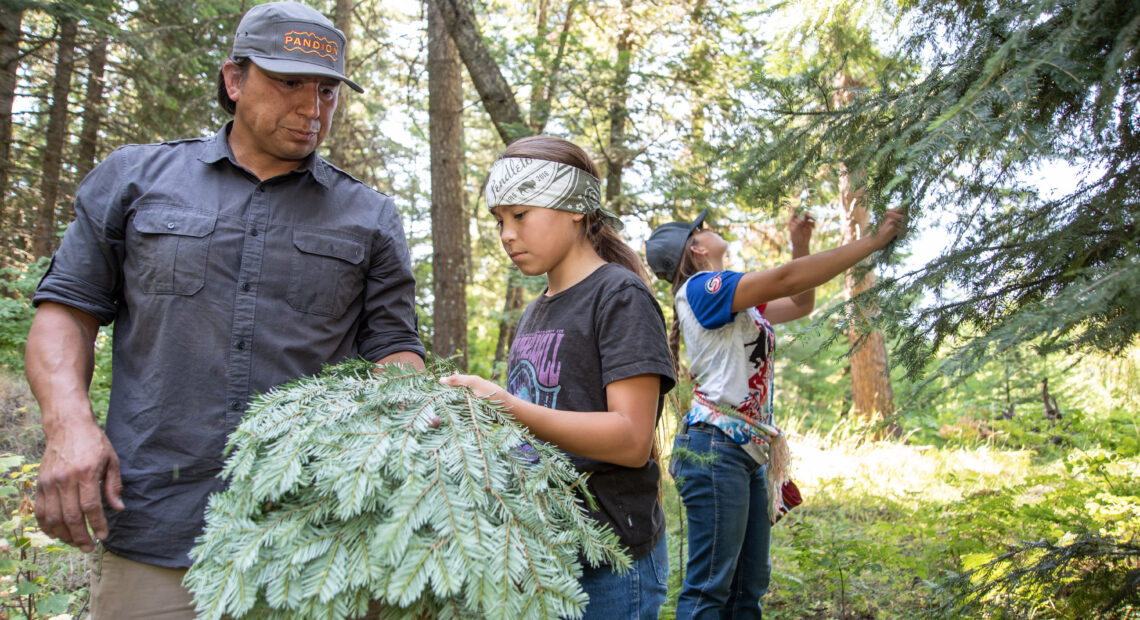
How some Northwest tribes cultivate land for First Foods, traditional medicines
Listen
(Runtime 3:51)
Read
Every time Jeremy Wolf heads out into the woods, it is an opportunity – more than just spending time in nature.
“It’s for us, just being Indian. Just doing the things that we have been taught over the years – being out here and telling the land who we are,” Wolf said.
Recently, he and his two daughters, all members of the Confederated Tribes of the Umatilla Indian Reservation, headed to the Rainwater Wildlife Area just outside Dayton, Washington. They were collecting small, fluffy fir boughs for their sweat lodge.
“Anytime I go up in the hills, we try to gather these, ’cause we sweat all year long,” Wolf said. “These [fir boughs] will last in the sweat house … maybe a month? It depends on how enclosed I keep it. It’s definitely noticeable when they dry out and it’s not that comfortable and loud.”
Branches snapped as he started breaking off smaller pieces. He said he began collecting thinner boughs after an older relative complained his branches were too rough to sit on.
“The idea is to layer it,” he said, explaining how the sweat lodge is set up.
The trio moved onto an open area, collecting more branches as they went.
“It just feels like these places, they kind of pull on you,” Jeremy said. “It’s like, ‘Alright, it’s time to get up in the hills, time to get up in the mountains.’”
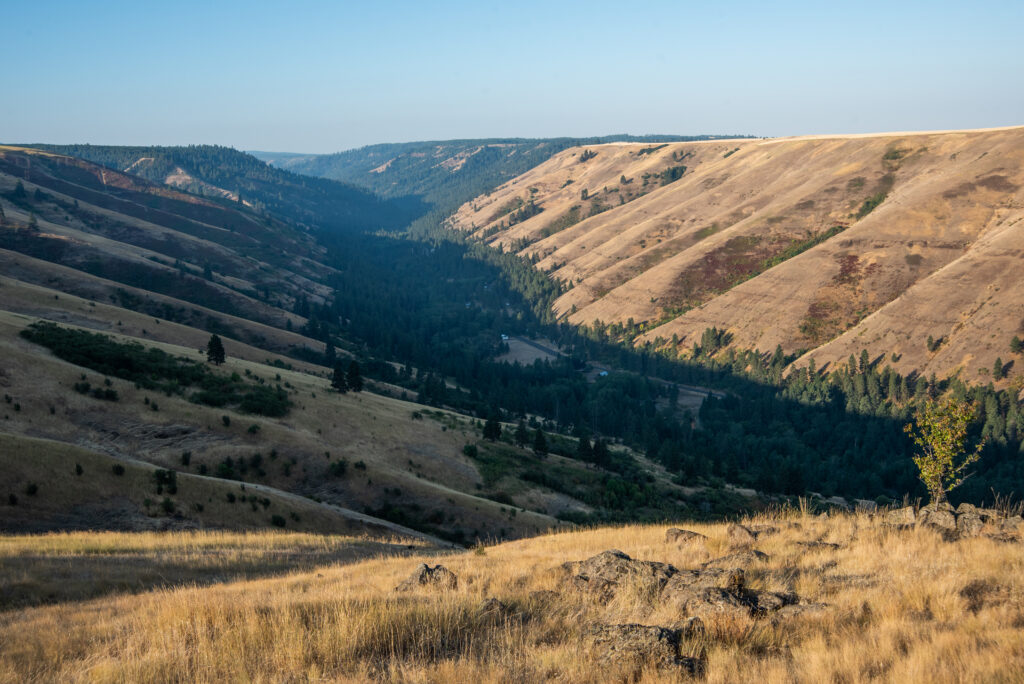
The Rainwater Wildlife Area is shown in the distance on either side of the South Fork Touchet River, about 8 miles south of Dayton, Wash. The Confederated Tribes of the Umatilla Indian Reservation (CTUIR) own and manage the land, which is open to the public, to maintain, protect and enhance fish and wildlife habitat. (Credit: Annie Warren / NWPB)
This area they’re gathering in is owned by the Confederated Tribes of the Umatilla Indian Reservation – it is one of four off-reservation sites, often far from where many tribal members live. The tribe bought the Rainwater property in 1998 with mitigation funds from the Bonneville Power Administration.
Andrew Wildbill, the wildlife program manager for the tribe’s Department of Natural Resources, said these properties are managed first and foremost for First Foods and traditional medicine gathering.
“Our traditional foods, our First Foods, are vital to our culture from our first breath to our last,” Wildbill said.
For the tribe, these First Foods are a major part of their creation story. The way it goes, Creator asked the foods, including salmon, deer, roots and berries, to care for people. In turn, the people would care for the foods through ceremonies and practices, like seasonal feasts and the use of sweat lodges. Tribal members say hunters and gatherers are taught to do no harm to these foods so future generations of foods are protected.
But that can be difficult today.
Colleen Sanders, who works with the tribe’s First Foods Policy program, said it’s important for non-Native people to keep that in mind as they learn about traditional ecological knowledge. As a non-Native person who is working for the tribe and learning about Indigenous culture, Sanders said people need to build relationships with plants and the land – and should leave the first foods, like huckleberries, for Indigenous people to harvest.
“We’ve seen more and more non-tribal people going out and harvesting cultural plants and then selling them. That’s a problem,” Sanders said.
Still, sites like the Rainwater property are open to everyone.
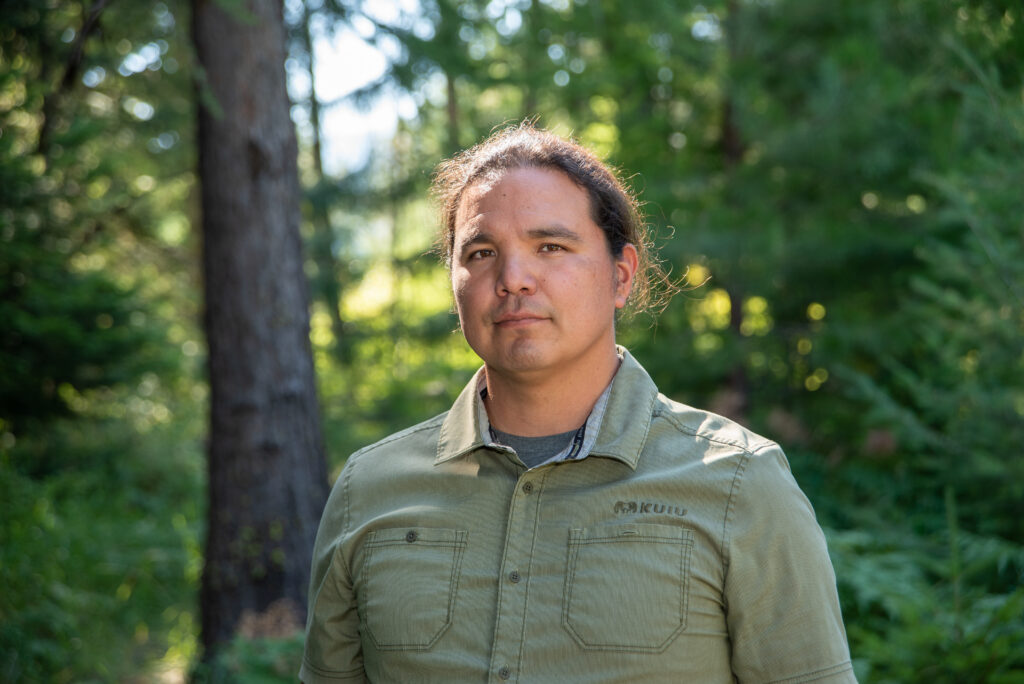
Andrew Wildbill is the Wildlife Program manager for the Confederated Tribes of the Umatilla Indian Reservation (CTUIR) in northeastern Oregon. Wildbill oversees the management of both on- and off-reservation lands, which the tribes manage by prioritizing first foods like salmon, deer, elk, roots and berries. (Credit: Annie Warren / NWPB)
While Rainwater is hours away from the reservation, it could be especially important for First Foods as the climate changes, Wildbill said.
“With a lot of tribes facing the same issue of living on non-prime land, because the settlers wanted all of the prime agricultural property around the reservations or near the reservations, with climate change, acquiring properties like Rainwater is going to give us an opportunity in the future to manage these stands appropriately for climate adaptation,” Wildbill said.
At the Rainwater property, managing some First Foods includes deer and elk hunting and root and berry gathering. Land managers said they’ve seen more ungulates migrate through the area as the tribe has improved habitat by thinning forests and doing prescribed burning.
These 11,000 acres act as a continuous corridor for deer and elk, says Jerry Middel, who helps manage the property for the tribe.
“If the tribes wouldn’t have bought [the land,] it would have been turned into a series of two-acre ranchettes all throughout this,” he said.
Tribal hunter Jesse Bronson said he has driven the two hours to the Rainwater property from his home in Mission, Oregon, for 20 years. Every year as he sets up camp, he said he thinks about how it’s all on land owned by the tribe.
“You can literally be up there for a week and not cover it all,” Bronson said. “The best part is all the diversity in the land; getting lost sometimes; leaving at dark and not getting back to camp until dark.”
He said he hopes his kids will one day carry on the tradition.
It’s a feeling Jeremy Wolf knows well. Back in Mission, he and his son, Aiden, prepped medicine bags of x̣áwš x̣áwš (pronounced ca-ow-sh ca-ow-sh) that Jeremy collected – at secret spots he’s not letting go anytime soon. The two sit inside their sweat lodge. The previous day’s fir boughs carefully laid out, filling the air with their fresh scent.
“We’re now here in our sweat lodge, or as we call him, ‘old man.’ This is like our church,” Jeremy Wolf said.
Aiden, a sophomore at Whitman College, said he’s trying to learn how to carry on traditions – sometimes a heavy burden. To that end, he said he and his cousins recently went fishing for the first time on their own.
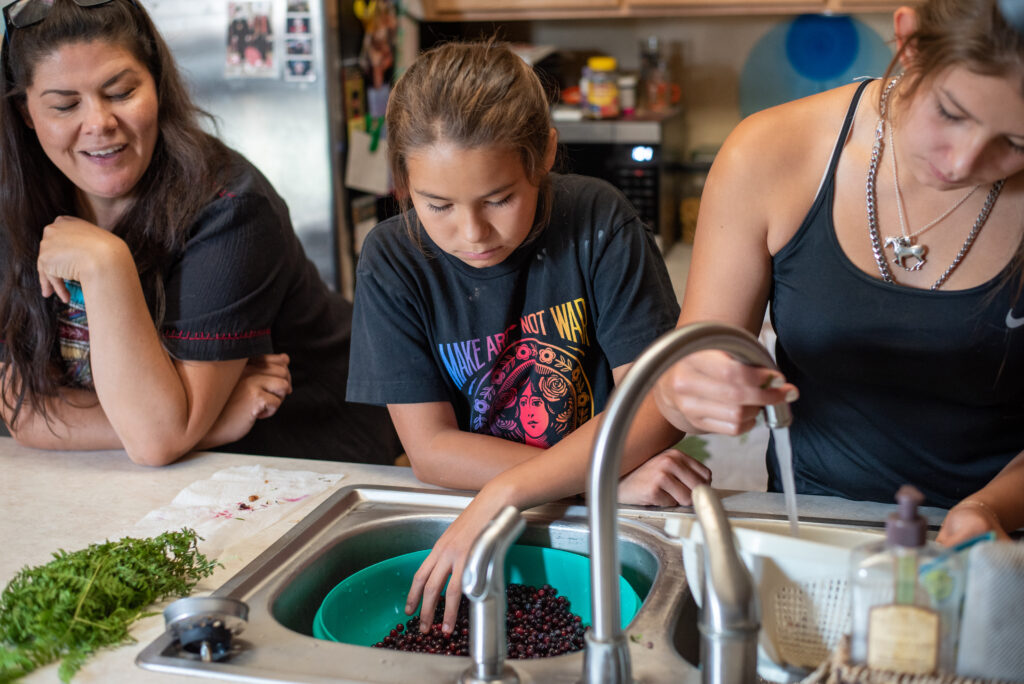
Althea Huesties-Wolf and her daughters Stella, center, and Manaia wash huckleberries and chokecherries in preparation for canning at their home on the Umatilla Indian Reservation in Mission, Oregon. These sacred first foods are considered “sisters” and are eaten at feasts and ceremonies throughout the year. (Credit: Annnie Warren / NWPB)
“We’ve just been scared that we’ll grow up, and we’ll be, in like my father’s position, in our 40s, and the younger kids will be asking us questions. We’re afraid that we won’t interpret it how our parents and our grandparents did,” Aiden Wolf said.
Inside their house, Aiden’s sisters and his mother and grandmother cleaned huckleberries and chokecherries they’d recently picked. Even though they have the right to gather in traditional and accustomed places, Althea Wolf said it’s always not that simple.
Every year she said the family collects chokecherries along the side of roads, driving in a pickup truck. But this year, Althea said, a new non-Native neighbor confronted them about gathering First Foods near his property. As they drove home later, they noticed he’d cut down all those chokecherry trees.
“It was just like, ‘Why would you do that?’ And technically, you know, there’s probably a certain amount of feet from the road that he doesn’t have a claim on, but he took them all out. And so we deal with that,” Althea Wolf said.
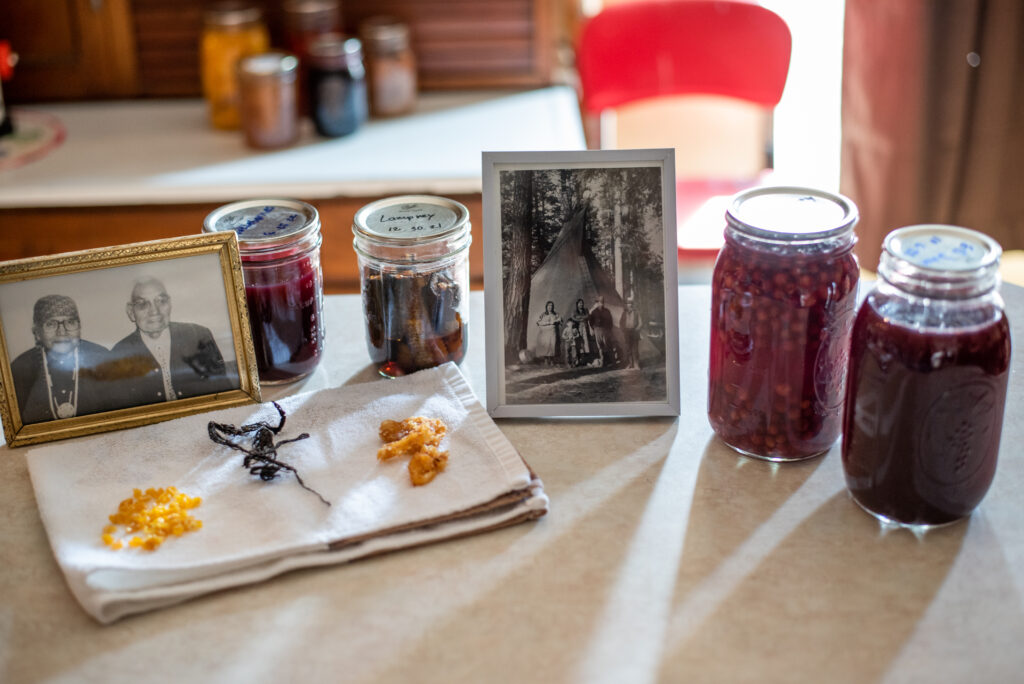
Photos of the Huesties-Wolf family ancestors are displayed at their home in Mission, Oregon, along with traditional foods like chokecherries, huckleberries, lamprey, dried moss and dried “biscuit,” made predominantly of x̣áwš (root.) Harvesting and preserving methods are passed down from generation to generation. (Credit: Annie Warren / NWPB)
That’s why she said it’s nice to have a place like the Rainwater property, where tribal members know the land is managed to protect First Foods and medicines.
“It can be a place for those First Foods to thrive, whether it’s plants or animals, pollinators. Everything has to come back,” she said
CORRECTION 10/11/23: An earlier version of this story misstated the type of boughs Jeremy Wolf collected. They’re fir boughs.
















